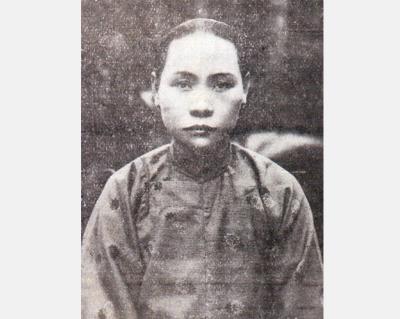“The primary thing that I want people to do is look at them and go ‘how pretty.’ It’s like you heard a song and went ‘that sounds nice,’ and then you start thinking about the lyrics afterwards. So the first thing I want is that they are attractive to the eyes.”
This was how Mark Caltonhill described his unique and arresting rebus-like poems, which update the traditional Chinese spring couplet, or chunlian (春聯), with the help of a digital camera.
“Basically they are two stanzas, seven lines in each,” he said. “Seven ideas, seven concepts, seven lines of poetry in each of the two stanzas with lots of correspondence.”
More than a year in the making, the 10 couplets — collectively called The Malarkey Phenomenon — are currently on display and sale at Citizen Cain, a restaurant on Dongfeng Street (東豐街), which will host a reception for the show this Sunday beginning at 1pm. Interspersed among the couplets will be Malarkey’s Amusement Park, a series of playful poems on photographs.
The exhibition also marks the soft launch of Caltonhill’s self-published book of writing, also called Malarkey’s Amusement Park, as well as a call for poetry and verse for a forthcoming compilation of writing by expats living in Taiwan that Caltonhill plans to publish in the summer of next year (submissions can be forwarded to jiyue.publications@gmail.com).
Caltonhill, who has lived in Taiwan on and off since 1992, working as a performer, translator and writer (his book Private Prayers and Public Parades was reviewed on Page 18 of the Nov. 9, 2003 edition of the Taipei Times), employed his considerable knowledge of Taiwanese culture, Chinese characters (he has a master’s degree in Chinese from the University of Edinburgh) and his travels throughout the country to create the couplets, which were printed on rice paper and professionally framed as silk scrolls.
HuHu (湖滬), based on a trip Caltonhill took to Penghu (澎湖), is fairly representative of the hanging scrolls in how the traditional couplet form is altered (digital images replace stylized characters) to investigate or meditate on a variety of themes.
In the couplet, Caltonhill juxtaposes images of Chinese characters either standing alone or in profusion — in one line characters have been spray-painted on a plastic container, in another they are on a menu written on a wall — with images of Penghu.
The second character in the Chinese word for Penghu, hu (湖), forms the first line on the right-hand scroll. The top line of the left-hand scroll is the Chinese character hu (滬), which means weir.
“It is a poem working on two levels,” Caltonhill said. “Going to Penghu and seeing all these things and the human relationship with his environment.”
The visual language that gives the couplets meaning is also what makes them difficult to unravel.
“To decipher the poems you need to know where [pictures of] the characters were taken,” he said.
The references are indeed idiosyncratic, and unless you’ve been to the restaurant or prison wall the images capture, it’s difficult to see any immediate deeper meaning — though Caltonhill pointed out that this was his intention. Written proficiency in Chinese and a deep knowledge of Taiwan’s history are helpful when deciphering the scrolls, so if your Chinese isn’t up to snuff be sure to bring along a friend who can point out the homophones.
Although the “lyrics” are written in Chinese, the visual music reveals a playful understanding of a traditional poetic form that rewards repeated viewing.
Those wishing to submit poetry, lyrics or verse to Caltonhill’s publishing company JiYue Publications (霽月出版社), which he established as a result of his “frustrations trying to get books published in Taiwan and the similar experiences of other writers,” should send submissions to jiyue.publications@gmail.com.
EXHIBITION NOTES:
WHAT: A Double Dose of Malarkey
WHERE: Citizen Cain, 67, Dongfeng St, Taipei City (台北市東豐街67號). Tel: (02) 2708-4557
WHEN: Opening reception on Sunday at 1pm ; exhibit runs through Feb. 28, 2009. Citizen Cain is open daily from 6pm to midnight

The Lee (李) family migrated to Taiwan in trickles many decades ago. Born in Myanmar, they are ethnically Chinese and their first language is Yunnanese, from China’s Yunnan Province. Today, they run a cozy little restaurant in Taipei’s student stomping ground, near National Taiwan University (NTU), serving up a daily pre-selected menu that pays homage to their blended Yunnan-Burmese heritage, where lemongrass and curry leaves sit beside century egg and pickled woodear mushrooms. Wu Yun (巫雲) is more akin to a family home that has set up tables and chairs and welcomed strangers to cozy up and share a meal

Dec. 8 to Dec. 14 Chang-Lee Te-ho (張李德和) had her father’s words etched into stone as her personal motto: “Even as a woman, you should master at least one art.” She went on to excel in seven — classical poetry, lyrical poetry, calligraphy, painting, music, chess and embroidery — and was also a respected educator, charity organizer and provincial assemblywoman. Among her many monikers was “Poetry Mother” (詩媽). While her father Lee Chao-yuan’s (李昭元) phrasing reflected the social norms of the 1890s, it was relatively progressive for the time. He personally taught Chang-Lee the Chinese classics until she entered public

Last week writer Wei Lingling (魏玲靈) unloaded a remarkably conventional pro-China column in the Wall Street Journal (“From Bush’s Rebuke to Trump’s Whisper: Navigating a Geopolitical Flashpoint,” Dec 2, 2025). Wei alleged that in a phone call, US President Donald Trump advised Japanese Prime Minister Sanae Takaichi not to provoke the People’s Republic of China (PRC) over Taiwan. Wei’s claim was categorically denied by Japanese government sources. Trump’s call to Takaichi, Wei said, was just like the moment in 2003 when former US president George Bush stood next to former Chinese premier Wen Jia-bao (溫家寶) and criticized former president Chen

President William Lai (賴清德) has proposed a NT$1.25 trillion (US$40 billion) special eight-year budget that intends to bolster Taiwan’s national defense, with a “T-Dome” plan to create “an unassailable Taiwan, safeguarded by innovation and technology” as its centerpiece. This is an interesting test for the Chinese Nationalist Party (KMT), and how they handle it will likely provide some answers as to where the party currently stands. Naturally, the Lai administration and his Democratic Progressive Party (DPP) are for it, as are the Americans. The Chinese Communist Party (CCP) is not. The interests and agendas of those three are clear, but